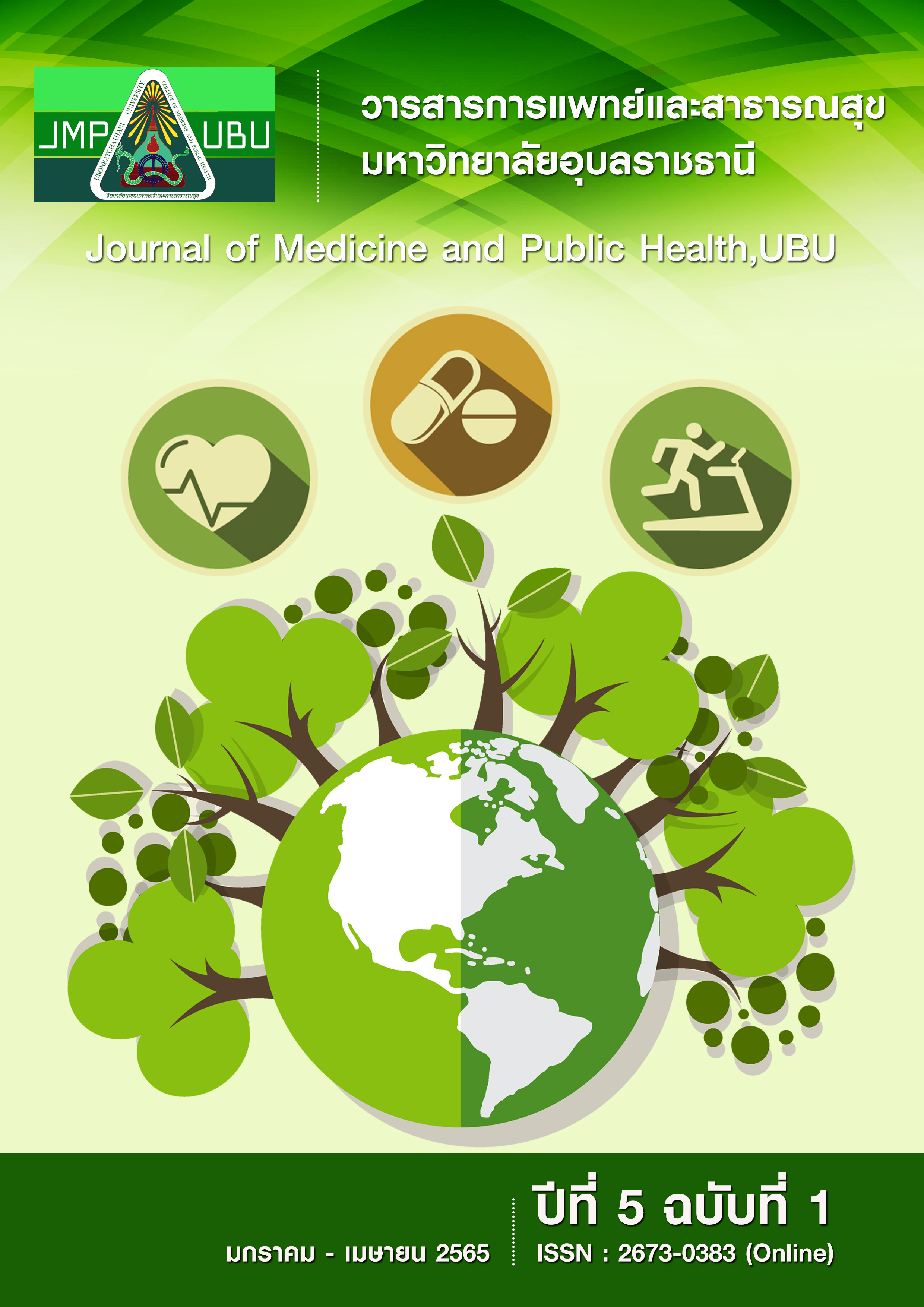ความชุกของการตรวจพบภาวะลิ่มเลือดอุดกั้นในหลอดเลือดแดงปอดเฉียบพลันโดยการใช้วิธีเอกซเรย์คอมพิวเตอร์หลอดเลือดแดงปอด ในผู้ป่วยที่สงสัยภาวะลิ่มเลือดอุดกั้นในหลอดเลือดแดงปอดเฉียบพลัน ในโรงพยาบาลสรรพสิทธิประสงค์
คำสำคัญ:
ลิ่มเลือดอุดกั้นในหลอดเลือดแดงปอดเฉียบพลัน, เอกซเรย์คอมพิวเตอร์หลอดเลือดแดงปอด, การประเมินความน่าจะเป็นทางคลินิก, Wells criteriaบทคัดย่อ
การศึกษาครั้งนี้มีวัตถุประสงค์เพื่อหาความชุกของการตรวจพบภาวะลิ่มเลือดอุดกั้นในหลอดเลือดแดงปอดเฉียบพลัน โดยการใช้วิธีเอกซเรย์คอมพิวเตอร์หลอดเลือดแดงปอดในผู้ป่วยที่มีอาการสงสัยภาวะนี้ในโรงพยาบาลสรรพสิทธิประสงค์ และลักษณะภาพจากการตรวจเอกซเรย์คอมพิวเตอร์ที่มีความแตกต่างกันในแต่ละระดับความรุนแรงของโรค ผู้วิจัยได้ทำการการศึกษาย้อนหลัง โดยเก็บข้อมูลผู้ป่วยที่สงสัยภาวะลิ่มเลือดอุดกั้นในหลอดเลือดแดงปอดเฉียบพลันและส่งตรวจเอกซเรย์คอมพิวเตอร์หลอดเลือดแดงปอด ตั้งแต่ 1 มกราคม 2560 ถึง 31 มีนาคม 2563 พบผู้ป่วยที่สงสัยภาวะลิ่มเลือดอุดกั้นในหลอดเลือดแดงปอดเฉียบพลันและส่งตรวจเอกซเรย์คอมพิวเตอร์ มีจำนวน 195 ราย ตรวจพบภาวะลิ่มเลือดอุดกั้นในหลอดเลือดแดงปอดเฉียบพลัน จำนวน 65 ราย คิดเป็นความชุกร้อยละ 33.3 เมื่อแบ่งผู้ป่วยตามระดับความน่าจะเป็นทางคลินิกโดยใช้ Wells criteria พบว่า มีภาวะลิ่มเลือดอุดกั้นในหลอดเลือดแดงปอดเฉียบพลัน ในกลุ่มความน่าจะเป็นทางคลินิกต่ำ ร้อยละ 15.2 กลุ่มความน่าจะเป็นทางคลินิกปานกลาง ร้อยละ 38.6 และกลุ่มความน่าจะเป็นทางคลินิกสูงร้อยละ 73.3 ลักษณะภาพจากการตรวจเอกซเรย์คอมพิวเตอร์หลอดเลือดแดงปอดที่มีความแตกต่างอย่างมีนัยสำคัญทางสถิติ (p < 0.05) ตามระดับความรุนแรงของโรค คือ อัตราส่วนขนาดห้องหัวใจล่างขวาต่อล่างซ้ายมากกว่า 1.0 และลักษณะรูปร่างของผนังกั้นหัวใจห้องล่างผิดปกติ โดยพบในกลุ่มความรุนแรงระดับปานกลาง (ร้อยละ 71.1 และ 68.4) และความรุนแรงระดับสูง (ร้อยละ 76.2 และ 90.5 ตามลำดับ)
Downloads
เอกสารอ้างอิง
Cohen AT, Agnelli G, Anderson FA, Arcelus JI, Bergqvist D, Brecht JG, et al. Venous thromboembolism (VTE) in Europe. The number of VTE events and associated morbidity and mortality. Thromb Haemost 2007;98(4):756-64.
Aniwan S, Rojnuckarin P. High incidence of symptomatic venous thromboembolism in Thai hospitalized medical patients without thromboprophylaxis. Blood Coagul Fibrinolysis 2010;21(4):334-8.
กมลวรรณ เอี้ยงฮง, ชิดชนก เปลี่ยนศรี, กรกฏ อภิรัตน์วรากุล. อาการทางคลินิกและผลการรักษาของผู้ป่วยที่ได้รับการวินิจฉัยว่าเป็นโรคลิ่มเลือดอุดกั้นในปอดเฉียบพลันที่ห้องฉุกเฉิน โรงพยาบาลระดับมหาวิทยาลัย ภาคตะวันออกเฉียงเหนือ ประเทศไทย. ศรีนครินทร์เวชสาร 2563;35:141-6.
Shujaat A, Shapiro JM, Eden E. Utilization of CT Pulmonary Angiography in Suspected Pulmonary Embolism in a Major Urban Emergency Department. Pulm Med 2013;2013:915213.
van Belle A, Buller HR, Huisman MV, Huisman PM, Kaasjager K, Kamphuisen PW, et al. Effectiveness of managing suspected pulmonary embolism using an algorithm combining clinical probability, D-dimer testing, and computed tomography. JAMA 2006;295(2):172-9.
Wolf SJ, McCubbin TR, Feldhaus KM, Faragher JP, Adcock DM. Prospective validation of Wells Criteria in the evaluation of patients with suspected pulmonary embolism. Ann Emerg Med 2004;44(5):503-10.
Ferreira EV, Gazzana MB, Sarmento MB, Guazzelli PA, Hoffmeister MC, Guerra VA, et al. Alternative diagnoses based on CT angiography of the chest in patients with suspected pulmonary thromboembolism. J Bras Pneumol 2016;42(1):35-41.
Vongchaiudomchoke T, Boonyasirinant T. Positive Pulmonary Computed Tomography Angiography in Patients with Suspected Acute Pulmonary Embolism: Clinical Prediction Rules, Thromboembolic Risk Factors, and Implications for Appropriate Use. J Med Assoc Thai 2016;99(1):25-33.
Wells PS, Anderson DR, Rodger M, Stiell I, Dreyer JF, Barnes D, et al. Excluding pulmonary embolism at the bedside without diagnostic imaging: management of patients with suspected pulmonary embolism presenting to the emergency department by using a simple clinical model and d-dimer. Ann Intern Med 2001;135(2):98-107.
Ceriani E, Combescure C, Le Gal G, Nendaz M, Perneger T, Bounameaux H, et al. Clinical prediction rules for pulmonary embolism: a systematic review and meta-analysis. J Thromb Haemost 2010;8(5):957-70.
Qanadli SD, El Hajjam M, Vieillard-Baron A, Joseph T, Mesurolle B, Oliva VL, et al. New CT index to quantify arterial obstruction in pulmonary embolism: comparison with angiographic index and echocardiography. AJR Am J Roentgenol 2001;176(6):1415-20.
Vedovati MC, Germini F, Agnelli G, Becattini C. Prognostic role of embolic burden assessed at computed tomography angiography in patients with acute pulmonary embolism: systematic review and meta-analysis. J Thromb Haemost 2013;11(12):2092-102.
Meinel FG, Nance JW, Jr., Schoepf UJ, Hoffmann VS, Thierfelder KM, Costello P, et al. Predictive Value of Computed Tomography in Acute Pulmonary Embolism: Systematic Review and Meta-analysis. Am J Med 2015;128(7):747-59 e2.
Dogan H, de Roos A, Geleijins J, Huisman MV, Kroft LJ. The role of computed tomography in the diagnosis of acute and chronic pulmonary embolism. Diagn Interv Radiol 2015;21(4):307-16.
Bach AG, Nansalmaa B, Kranz J, Taute BM, Wienke A, Schramm D, et al. CT pulmonary angiography findings that predict 30-day mortality in patients with acute pulmonary embolism. Eur J Radiol 2015;84(2):332-7.
Konstantinides SV, Meyer G. The 2019 ESC Guidelines on the Diagnosis and Management of Acute Pulmonary Embolism. Eur Heart J 2019;40(42):3453-5.
Donze J, Le Gal G, Fine MJ, Roy PM, Sanchez O, Verschuren F, et al. Prospective validation of the Pulmonary Embolism Severity Index. A clinical prognostic model for pulmonary embolism. Thromb Haemost 2008;100(5):943-8.
Moore AJE, Wachsmann J, Chamarthy MR, Panjikaran L, Tanabe Y, Rajiah P. Imaging of acute pulmonary embolism: an update. Cardiovasc Diagn Ther 2018;8(3):225-43.
Aviram G, Rogowski O, Gotler Y, Bendler A, Steinvil A, Goldin Y, et al. Real-time risk stratification of patients with acute pulmonary embolism by grading the reflux of contrast into the inferior vena cava on computerized tomographic pulmonary angiography. J Thromb Haemost 2008;6(9):1488-93.
นรินทร อู่ทรัพย์. ผลการตรวจทางรังสีวิทยากับปัจจัยทำนายความรุนแรงของผู้ป่วยโรคลิ่มเลือดอุดกั้นในปอดเฉียบพลัน โรงพยาบาลสมเด็จพระยุพราชสระแก้ว. วารสารศูนย์การศึกษาแพทยศาสตร์คลินิก โรงพยาบาลพระปกเกล้า 2563;37(2):105-14.
ดาวน์โหลด
เผยแพร่แล้ว
รูปแบบการอ้างอิง
ฉบับ
ประเภทบทความ
สัญญาอนุญาต
ลิขสิทธิ์ (c) 2021 วารสารการแพทย์และสาธารณสุข มหาวิทยาลัยอุบลราชธานี

อนุญาตภายใต้เงื่อนไข Creative Commons Attribution-NonCommercial-NoDerivatives 4.0 International License.
เนื้อหาและข้อมูลในบทความที่ลงตีพิมพ์ในวารสารการแพทย์และสาธารณสุข มหาวิทยาลัยอุบลราชธานี ถือเป็นข้อคิดเห็นและความรับผิดชอบของผู้เขียนบทความโดยตรง ซึ่งกองบรรณาธิการวารสารไม่จำเป็นต้องเห็นด้วย หรือร่วมรับผิดชอบใด ๆ
บทความ ข้อมูล เนื้อหา รูปภาพ ฯลฯ ที่ได้รับการตีพิมพ์ในวารสารการแพทย์และสาธารณสุข มหาวิทยาลัยอุบลราชธานี ถือเป็นลิขสิทธิ์ของวารสารการแพทย์และสาธารณสุข มหาวิทยาลัยอุบลราชธานี กองบรรณาธิการไม่สงวนสิทธิ์ในการคัดลอกเพื่อการพัฒนางานด้านวิชาการ แต่ต้องได้รับการอ้างอิงที่ถูกต้องเหมาะสม






